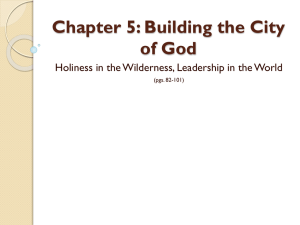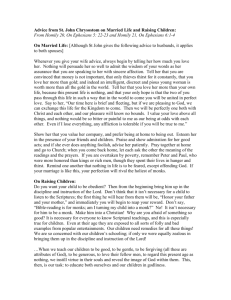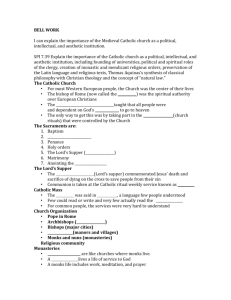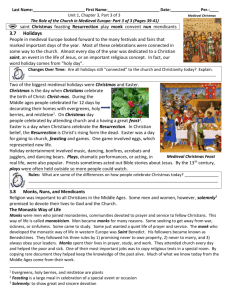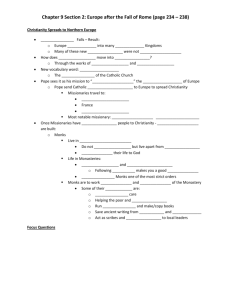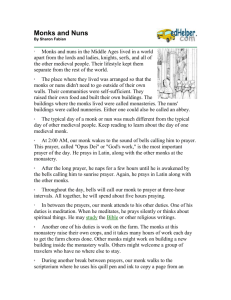The Monk as a Messenger - St. George`s Sunday School
advertisement
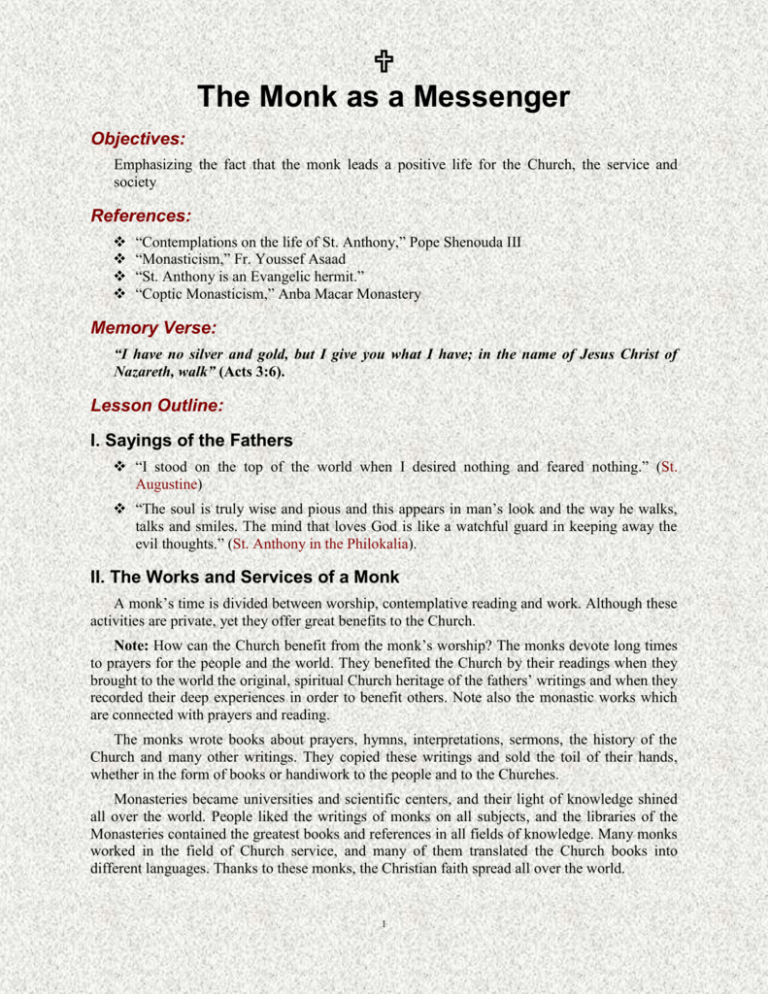
The Monk as a Messenger Objectives: Emphasizing the fact that the monk leads a positive life for the Church, the service and society References: “Contemplations on the life of St. Anthony,” Pope Shenouda III “Monasticism,” Fr. Youssef Asaad “St. Anthony is an Evangelic hermit.” “Coptic Monasticism,” Anba Macar Monastery Memory Verse: “I have no silver and gold, but I give you what I have; in the name of Jesus Christ of Nazareth, walk” (Acts 3:6). Lesson Outline: I. Sayings of the Fathers “I stood on the top of the world when I desired nothing and feared nothing.” (St. Augustine) “The soul is truly wise and pious and this appears in man’s look and the way he walks, talks and smiles. The mind that loves God is like a watchful guard in keeping away the evil thoughts.” (St. Anthony in the Philokalia). II. The Works and Services of a Monk A monk’s time is divided between worship, contemplative reading and work. Although these activities are private, yet they offer great benefits to the Church. Note: How can the Church benefit from the monk’s worship? The monks devote long times to prayers for the people and the world. They benefited the Church by their readings when they brought to the world the original, spiritual Church heritage of the fathers’ writings and when they recorded their deep experiences in order to benefit others. Note also the monastic works which are connected with prayers and reading. The monks wrote books about prayers, hymns, interpretations, sermons, the history of the Church and many other writings. They copied these writings and sold the toil of their hands, whether in the form of books or handiwork to the people and to the Churches. Monasteries became universities and scientific centers, and their light of knowledge shined all over the world. People liked the writings of monks on all subjects, and the libraries of the Monasteries contained the greatest books and references in all fields of knowledge. Many monks worked in the field of Church service, and many of them translated the Church books into different languages. Thanks to these monks, the Christian faith spread all over the world. 1 th th In the 5 and 6 centuries, the Coptic monks sent missions to different parts of the world. History tells us of monks who went to Switzerland and seven monks who reached North Ireland and preached the Gospel; they were great in art and language. In the Irish liturgy, there is a prayer for them: “Remember O Lord the Egyptian monks who brought us the true faith.” In the Coptic Church, we remember St. Anthony who resisted the Arian heresy and Anba Shenouda (St. Shenouti), the Head of Anchorites, who was the leader of a rare spiritual, social and patriotic movement of renaissance in Egypt. II. Monasticism is a Challenge to Luxury and Worldly Life There was a time when the Christian Church took characteristics of luxury after the end of the periods of persecutions. The Church began to compete with the kings of the earth in material wealth and authority. At that time, the monks, in their monasteries, challenged the world by leading a life of abstinence and voluntary poverty. There is no doubt that they defied the position of the world which affected the lives of Christians and kept them away from the original model of the Lord Christ; He was meek and modest, had no place to rest his head, and gave us the greatest example of the life of abstinence and simplicity in food, clothing and property. Those are the monks and the fathers who left the world behind, sold all they had, deprived themselves of money. They went to the desert to worship the Lord, pray to God the whole night and have the sweetest talk between the lover and the beloved; they dwelt in the wilderness, in mountains and in caves. They did all this because of their great love for Christ the King. III. Christianity Today Needs Monasticism Monasticism is the practical incarnation of Divine Love. It is love for God, which is superior to any other love and sublimes with the soul in the life of hymns and prayers. It is love for the people who were created in God’s image and after His likeness. It is love that leads to sacrifice and giving. Because of his love for God, a monk lives in solitude to worship, contemplate and keep his mind and feelings to love God. He gives up worldly cares, and the joy of his heart and the desire of his soul are for God only and no one else. Because of his love for his brethren, he gives the world all he has. He has no material things to give, but he has spiritual gifts with which he can serve humanity; “I have no silver and gold, but I give you what I have; in the name of Jesus Christ of Nazareth, walk” (Acts 3:6). St. Gregory says, “There are two facts which each man can see: the first is work and the second is contemplation.” The first makes us toil and work hard to purify our hearts, and with the second, we become quiet so we can see God. (Tell your students the story of Anba Bishoy who carried our Good Savior.) St. Gregory says, “The Lord Christ, glory be to Him, set two kinds of life through His behavior: The life of service and work and the life of calmness and contemplation.” So, each one of us needs the two kinds of life: Service and Contemplation. IV. The World Needs Practical Models of Holiness God desires that each Christian be a saint who consecrates his own senses, body and soul. A monk devotes himself to the life of virginity to get rid of the means of earthly attractions, so his soul walks easily and happily in the way of Christ, and enjoys a perpetual wedding without end. 2 Married people can also practice the life of holiness if they live with a holy heart and pure feelings, since marriage is a holy Sacrament. But a monk who has dedicated his life to God prefers virginity to devote his heart to Christ and to serve His Holy Name. He has chosen God in whom he rejoices. (In the Old Testament there were sacrifices and burnt offerings. Why do we call the holy laity a sacrifice and the holy monk a burnt offering?) V. The World Needs Prayers We all pray, but the monk left the world and devoted his life to service, prayers and hymns. He does not offer these for himself only but also for the world and for all the people. While people are asleep, the congregation of monks raises their prayers like pillars of light. You remember Anba Macari who saw a pillar of light coming out of the mouths of St. Maximus and St. Domadius as they were praying, so that God might destroy wars, epidemics, evil deeds, things that cause people to stumble, doubts, suspicion and evil images. They were praying that the Lord might send His mercies to you and to the whole world. VI. The World Needs Discipleship A. Through a model The world is in need of high ideals to raise the standard of conduct. Monasticism is struggling to reach Christian perfection. Who can read the Paradise of the monks and not long for virtue? Who can read the memoirs of saints and not desire holiness? St. Isaac said, “Reproach the evildoers by the chastity of your conduct, not by words.” For example, St. Augustine was an evil man while he was in Italy, but thanks to the memoir of the Egyptian St. Anthony, he was attracted to the life of repentance and became one of the bishops of the Church. B. Through growth in virtues Monasticism gives us models of virtue, showing the possibility of carrying out Christ’s commandments. A man with a demon struck a monk on his cheek, and when the monk turned his other cheek to receive the second blow, the demon went out of the man’s body crying, “Woe be to us O monks, you terrify us by your obedience to the commandments of Christ.” C. Through discipleship to the writings of the fathers and their lives The Church regards the writings of the fathers as treasures because they are the fruits of the practical tests of their daily lives. These tests were the results of their continuous relationship and long fellowship with God. They were filled with the Holy Spirit. We have to bear in mind that the fathers’ teachings, in their simplicity, are the greatest source of Christian teachings. The service of the monks was not confined to teaching through books and letters, but they also transmitted this precious scientific and spiritual heritage to the next generations through discipleship. Whenever a monk was known for his knowledge and holiness, groups of disciples rushed to him in great numbers. Hence, the idea of a university arose. One of the writers of history said, “The renaissance that arose in the world of literature and thought during the 12th and 13th centuries was associated with the rise of human sciences and 3 universities in the Middle Ages.” That renaissance was the fruit of those old monasteries which were established by St. Pachomius the founder of the Coenobitic System. Monasticism was and still is a spiritual power in the Church. This spiritual power supports the Church by prayers and provides it with religious and dogmatic research; when necessary, monks leave their monastery and go to the world to serve the people through spiritual power. D. Through Obedience A monk obeys God, the Holy Scriptures and the Church; his slogan is “We must obey God rather than men.” Through his obedience, he offers a good method that suits the present generation and emphasizes the value of spiritual obedience, which is the basis of sound relationship in the family, society and Church. Conclusion/Questions: What are the main elements of monastic life? Show how monasticism was a challenge to the corrupt positions of the world. St. John Chrysostom says, “The monk’s vow should also be offered by married people.” How can this be? Can a Christian lead a life of contemplation and a life of service at the same time? How can a monk do that? Mention some famous monks who performed great services to the Church. How can the Church benefit from monasticism and monasteries at this present age? What do we want them to do? How is the world in need of them? Applications: Pay a visit to a monastery, and together with some monks, discuss the benefits of monasticism for society. Sit with one of the holy monks and try to benefit from his experience. Go into retreat in the House of Retreat. 4 THE COPTIC CHURCH AND THE MONASTIC MOVEMENT AN EVANGELIC ASCETICISM The Coptic Church is known by her ascetic attitudes, not only because she started the monastic movements but because these attitudes represent characteristics of her life of worship. These attitudes have an evangelic base; "For what is a man profited, if he shall gain the whole world and lose his own soul?!" Matt. 16:26. "Sell all that you have and distribute to the poor ... and come, follow Me" (Luke 18:22). "But I discipline my body and bring it into subjection, lest when I have preached to others, I myself should become disqualified" (1 Cor. 9:27). The Copts enjoyed this evangelic thought, and their hearts were flamed by the love of eternity. THE ASCETIC LIFE AND THE WORLD TO COME1 The ancient Egyptians believed in the so-called "resurrection," that is, it was possible for the dead to live again forever if certain ceremonies were carried out2. For this reason the bodies must be well kept in sealed tombs, so that only the soul (ka) can visit the tomb and dwell in it. No doubt then, those tombs were provided with all articles used in daily life: clothes, food and drinking vessels, cutlery, chairs etc. Besides the actual furniture, the deceased was supplied with his weapons and carriages. The ornaments of women and the playthings of children, such as dolls and balls were also placed in the tomb. When the Egyptians were converted to Christianity, their longing for the world to come increased, based on the evangelic truth. Instead of their interest in the return of the spirits to their bodies, which are preserved in tombs, they desired that their spirits, minds and hearts be lifted up to enjoy heavenly life, even while their bodies were on earth. In other words, their longing for the world to come paved the way to practice ascetic life on a biblical basis. THE CONCEPT OF COPTIC ASCETICISM Asceticism in the Coptic Church is not a goal in itself, that believers desire to attain, but it is a practical response to divine love. Our Lord gave Himself on our behalf, and we in turn long to give ourselves a loving-sacrifice for God's sake. We abstain from temporary pleasures as a sign of our internal desire to enjoy divine delight through the new life in Jesus Christ. Believers, especially monks, have one purpose: to attain the inner heavenly Kingdom as a pledge of their hope for eternal life and meeting with God. ASCETICISM AND CHURCH LIFE On many occasions, I spoke about asceticism in the Coptic Church and its effect on her theological concepts, her life of worship, her conduct, etc. Here, I refer just to the following points: 1. The effect of the ascetic life on the Coptic Church is very clear, especially in her worship: the hymns are lengthy but very sweet and soul-comforting, the fastings are long and INTRODUCTION TO THE COPTIC ORTHODOX CHURCH , FR. TADROS Y. MALATY, ST. GEORGE'S COPTIC ORTHODOX CHURCH SPORTING – ALEXANDRIA, EGYPT, 1993 5 numerous (more than half of the year), and the liturgies concentrate on the advent of Christ. 2. Her martyrs are innumerable, so that some historians look upon her existence as a divine miracle. It was not uncommon that an entire population of a city would hurry joyfully to their persecutors to gain crowns of martyrdom. 3. The spiritual ascetic thought had its own effect on the Alexandrian theology because it has a soteriological attitude and concentrate on the enjoyment of salvation. Theology is not philosophical thoughts to be discussed, but it is rather an experience of God's redeeming acts in the believer's life4. 4. The ascetic life does not imply enmity with the body, its senses and energies but rather it looks upon the body in sanctity as aiding the soul5. 5. The ascetic life prepared the way to the monastic movement in all its forms: monarchism, coenobitic and communal systems, which aim at the unity with God in different forms. Therefore, the Egyptians understood "monarchism" not as isolation from men but as unity with God. The monk does not isolate his heart from the human race but loves everybody wholeheartedly, even if he lives in the desert. He prays for them and shares their sorrows, begging earnestly for their salvation. 6. Many of the Egyptian Fathers resisted the exaggeration in asceticism, especially if it was practiced without wisdom or discernment. THE MONASTIC MOVEMENT6 In Egypt, all monastic forms were started in the fourth century in order to re-attract the heart of the Church to the inner life, after the country had accepted Christianity and the Emperor had opened his door to bishops and priests. Undoubtedly, the various monastic forms, or orders, did not start on the basis of previous Church plan, but they came to light through instinct love that flamed the hearts of many early Christians. 1. In the Apostolic age, many believers practiced asceticism to enjoy the perfect life as revealed in the Gospel. 2. The eschatological attitude of the Church flamed the believers' longing for the Bridegroom's advent. On this base, some believers preferred to live in virginity and devote all their time to worship as a spiritual preparation for the heavenly wedding feast. In the second century, Christian virgins used to walk in the liturgical processions after the priests and before widows. Many communities of virgins lived in Alexandria and many other countries all over the world, and many treatises on "Virginity" represented a vital part of the patristic writings in the first three centuries. 3. Some felt not only the need to live as virgins and have no family responsibilities but also the need for a spiritual atmosphere. Women lived together in a house to assist one another spiritually. Men preferred to leave the cities and live in simple huts in villages. They were called "devotees." Some Christians felt thirsty towards the angelic life and escaped to the deserts. We know only a small number of them; one of them is St. Paul the First Hermit, who lived in the desert more than ninety years (c. A.D 250-341). 6 4. Although many preceded him in practicing monasticism, it was St. Anthony the Great who established the monastic movement and is considered to be the father of the monastic family for the following reasons: His close relationship with the leaders of the Church, especially Pope Athanasius who wrote about him to the Roman world; and his cave was opened after twenty years of complete isolation, and many leaders of monasticism became his disciples. Philosophers and rulers came to discuss reason with him. He also was an active member of the Church who visited Alexandria in the period of persecution to serve and encourage the confessors and to assist St. Athanasius in his struggle against Arianism. 5. St. Pachomius established the coenobitic system because he was aware that the anchoric order was not fit for all those who desired the monastic life. 6. Sts. Macari the Great, Amoun and others established the communal order in Wadi-elNatroun, where many came from all over the world to live the monastic life in Egypt and to write about Egyptian monasticism. It is worthy to note that the leaders of the three forms of monasticism were not prejudiced to their own orders but praised the other orders. 7. Women monastic movement started side by side with that of men, and monks contributed to the building of nunneries. Many female leaders who played effective roles appeared, such as Abbess Sarah and Abbess Theodora. Many Egyptian and foreign women were disguised in men garments to live an ascetic life in monasteries for men, and they became pioneers in asceticism and spirituality. SOME EXAMPLES OF MONASTIC LEADERS 1. ST. PAUL OF THEBES (The First Pilgrim - Wanderer): In the year 374 or 375 A.D., St. Jerome wrote his biography. St. Paul, a native of the lower Thebaid in Egypt, was highly skilled in both Greek and Egyptian knowledge. Being about sixteen year old, upon the death of his parents, he came into a rich inheritance during the persecution of Dicius (250 A.D). The young man fled to the desert when his brother Peter threatened to betray him. When the blessed St. Paul, already one hundred and thirteen years old, was leading a heavenly life on earth, St. Anthony visited him. St. Paul called St. Anthony by his name, and they spoke about God's wonderful works, praising Him. At sunset, a raven alighted upon a branch of a tree and gently swooped down and laid a whole loaf of bread before them, although it used to bring only half a loaf every day for St. Paul to eat. On the third day, St. Paul asked St. Anthony to go and fetch him a cloak that Bishop Athanasius had given him, in order to wrap his body. When St. Anthony returned to the cave, he found St. Paul kneeling as if he was praying but discovered that he had already departed. Two lions came and dug the ground with their paws so that the corpse of the blessed man might be buried. 2. ST. ANTHONY: He was born around A.D. 251 in Coma (Kemn-el-Arouse), in Middle Egypt. He was eighteen years old when he entered the Church and heard the word of the Gospel: "If you want to be perfect, sell all you have, give to the poor and come follow Me" Matt. 19:21. He sold his land, left his sister in a community of virgins, and lived in a hut under the guidance of a recluse. Later, he departed to the western desert to live in a 7 tomb carved in a mountain, where he struggled in spiritual wars against demons. He was about thirty-five years old when he settled on the east bank of the Nile, at Pispir, to live as a hermit. Many came to him to copy his holy life. He again retired into solitude in the inner wilderness, in the "El- Kalzam Mountain." He urged himself to visit Alexandria in A.D. 316 to assist the martyrs and in A.D 352 to help St. Athanasius in his controversy against Arianism. Many came to him as disciples. He departed to the Lord in A.D 356. Among his disciples were Sts. Hilarious of Gaza, Macari of Sheheet, Amoun of Nitria and Paul the Simple. 3. ST. PACHOMIUS: He was born in about A.D. 290, in Upper Egypt, and he was converter to Christianity in Esnah (Latopolis), in Upper Egypt, because of the generosity of its people and their love towards their enemies. He left the army and was baptized in A.D. 307 in Chenoboskion. He became a disciple of Palamon the Hermit until an angel appeared to him and guided him to the Coenobitic system. As a successful leader, he was concerned with the salvation of everybody and established many monasteries in Upper Egypt in perfect order, in addition to two nunneries under the guidance of his sister. His coenobitic laws were translated into Greek and Latin, and they were used by St. Basil the Great and by the Gaulians in the fifth Century. Benedict, the Father of the western monasticism and Caesarius of Arles adopted them too. 4. ST. AMOUN: He was a contemporary to St. Anthony. He was born about A.D. 275. When he was a young man of about twenty-two (A.D 297), he was constrained by his uncle to marry but he lived with his wife as ascetics. After eighteen years (c. A.D. 315), she asked that they live apart for the progress of their spiritual life. He then went to Mount Nitria, where many came to him as disciples and where he established the communal system. It is a system half way between monarchism and the coenobitic system; the monks do not share in worship and food daily, but they gather on Saturdays and Sundays. They live in cells or caves around a Church. 5. ST. MACARIUS THE GREAT (c. 300-390 A.D): He was the founder of the communal order in the desert of Scetis. He visited St. Anthony at least twice. His parents obliged him to marry, but God permitted that his wife would die while she was a virgin. He lived in a hut, in a village, practicing asceticism for about ten years under the guidance of a hermit. When he longed for anchorism, he went to Scetis, following a Cherub. He practiced worship and asceticism with an open heart, and therefore many came to him as disciples from the East and the West. 6. ST. SHENOUDA THE ARCHIMANDRITE (the Head of Anchorites): He was an abbot of the White Monastery of Atribe in the desert of Thebes for more than sixty five years (in the forth/fifth century), leading 2200 monks and 1800 nuns. He is called “Archimandrite” because he used to practice the hermitic life from time to time and encouraged some of his monks to withdraw to the desert after a few years of coenobitic life. In A.D. 431, he accompanied St. Cyril the Great to the Ecumenical Council of Ephesus. He created Egyptian nationalism or Coptism, eliminating every Hellenistic culture from the Coptic literature, and did not permit any foreigner to be admitted to his monasteries. Besides his deep spirituality, he was a political leader and a social reformer. 7. ST. SARAH THE ABBESS: The first monastic community in the world for women was founded in Alexandria by St. Syncletica, whose biography and teachings were preserved by Pope Athanasius. St. Pachomius also established two convents for women, and many women hermits lived in the desert. Many foreign abbesses came to Egypt, such as St. 8 Melania the Great (in A.D. 374) and her granddaughter, Melania the young (in A.D. 418). We also cannot ignore St. Mary of Egypt who was converted in Jerusalem; for forty-eight years, she dwelt in the desert beyond Jordan, seeing nobody except St. Zosima twice in the last two years of her life. Many abbesses were endowed with the grace of true leadership and spiritual discernment. One of them was Sarah, who lived in Pelusium; her sayings were treasured by the desert Fathers. 8. ST. HILARY: The daughter of Emperor Zeno, in the fifth century, fled to the desert of Scetis to practice asceticism while she was disguised in monk's clothes. When her sister Theopesta was possessed by an evil spirit, the elders of the wilderness sent her to Hillary without knowing that she was a woman. She prayed for her all night and kissed her. When she was healed, the emperor was astonished at the monk who prayed for his daughter and was kissing her. He called her to his palace, and when the disguised monk was promised that she would return to her cell, she uncovered her personality. EGYPTIAN MONASTICISM AND THE CHRISTIAN WORLD7 Coptic monasticism is considered the most profound spiritual revival that ever happened in the history of the Church. It attracted people from all over the world to practice the angelic life in Egypt: Greeks, Romans, Cappadocians, Libyans, Syrians, Nubians, Ethiopians, etc. The following is a brief account of the effect of Coptic monasticism on the whole Christian world: 1. Pope Athanasius was responsible for the introduction of the monastic movement to the Roman religious life during his exile in Treve (A.D. 336-337) and his flight to Rome in A.D. 339. He also wrote his book "Vita Antonii" about A.D. 357, which was distributed all over the world. 2. The Pachomian rules were translated into Greek by Palladius and into Latin by Jerome. St. Basil visited the Pachomian monasteries and was profoundly impressed by what he saw. 3. The rules of Benedict of Nursia (c. A.D. 480-550) were based on the Pachomian rules. 4. St. John Cassian (A.D. 360-435) stayed seven years in Egypt and wrote his two famous books: the "Institutes" and the "Conferences." 5. Evagrius Ponticus (A.D. 346-399), an eminent personality in the history of Christian spirituality, lived as a monk for two years in Nitria then fourteen years in the "Cells." 6. Sts. Jerome (A.D. 342-420) and Rufinus (A.D. 345-410) visited Egypt. 7. Palladius (c. 365-425 A.D.), bishop of Helenopolis and historian of early monasticism, spent several years with the monks of Egypt, where he was a disciple of Evagrius Ponitcus and composed his book "Lausaic History" about the year A.D. 419. 8. Mar Eugenius became a disciple of St. Pachomius. He established a monastery in Nisibus, Persia and translated St. Pachomius' rules to Persian and Syrian about the middle of the fourth century. According to the Chaldean tradition, seventy Egyptian monks helped him built several monasteries at Nisibus. 9. St. Hilarious of Palestine (c.291-371 A.D.) became a disciple of St. Anthony and returned to his own land to practice asceticism. 9 10. St. Epiphanius (A.D. 315-403), bishop of Salamis in Cyprus, had been instructed in monastic, Coptic thought. 11. The "Dialogues of Sulpicius Severus" (c. A.D. 430), written by a traveler called Postumian, recorded what he had seen in Egypt. It was a very favorable view of Egyptian monasticism. 12. Etheria (Egaria), a Spanish abbess or nun in the fourth century, visited Egypt. 13. St. Melania the elder, a Roman lady, visited the desert of Egypt. 14. St. John Chrysostom stayed in one of the Pachomian monasteries in Upper Egypt from 373 to 381 A.D. THE COPTIC MONASTIC MOVEMENT TODAY One of the remarkable aspects of the Coptic Orthodox Church today is the continual increase of those who are eager to join monastic life. At present, in Egypt, there are eleven monasteries scattered in the diverse desert regions and six convents within the cities. All of them are expanding and are being renovated. His Holiness Pope Cyril VI established St. Minas' Monastery in Mareotis, south west of Alexandria. H. Holiness Pope Shenouda III takes care of St. Pishoy's Monastery in Wadi-el-Natroun. He established a papal residence in this area because of his eagerness to practice monastic life in addition of his tremendous pastoral responsibilities. Usually, he spends three days per week in this monastery. Some of the young men who immigrated to U.S.A., Canada and Australia and who succeeded in their careers were admitted to the monasteries in Egypt. _______ 1. Fr. Tadros Malaty: The Coptic Church, "Church of Alexandria," Melbourne 1978, p. 6-7. 2. Hastings Encycl. of Religion and Ethics vol. 1, p.113. 3. M.E. Harkness: Egyptian life and history, p. 17-19. 4. Fr. T. Malaty: The terms : "Physis & Hypostasis" in the Early Church, Sept. 1986, p. 19f. 5. Fr. T. Malaty: Dict. of the Fathers and the Saints of the Church, vol. 1, 1986, p.12 (in Arabic). 6. Fr. Malaty: The Coptic Orthodox Church, 1986, p. 9-11. 7. Ibid, p. 78-83. 10 NAME: ____________________________ first last The Monk as a Messenger Verse to Memorize: I have no silver and gold, but I give you what I have; in the name of Jesus Christ of Nazareth, walk. Acts 3:6 1. Who is called "the father of monks"? d) St. Macarius a) St. Athanasius e) None of the above b) St. Anthony c) St. Paul 2. Where did monasticism first start? a) Greece b) Rome c) Israel d) Egypt 3. What is the main purpose of becoming a monk or nun? a) Enjoying the freedom of being alone b) Becoming a great saint c) Not having to work or study d) Forsaking the world to enjoy a new life with Jesus Christ e) Not getting married 4. The main elements of monastic life are: a) Obedience to God b) Chastity c) Voluntary poverty d) Forsaking worldly cares e) All the above 5. Who is the founder of the Coenobitic system of monasticism? c) St. Macarius a) St. Pachomius d) St. Shenouda b) St. Anthony 6. Describe the Communal system of monasticism? 7. How does the Church benefit from monasticism and monasteries? 11 .

